
At LabTwin, understanding our clients' pain points and goals is paramount to ensure that our technology will bring them value that they will value! We became very familiar with the challenges laboratories face and strive to provide innovative solutions that addresses these concerns head-on. Here are the 7 most classic pain points, challenges or goals that we have encountered so far.
This blog is the master blog of a series which will dive into each of these challenges.
Fully transitioning from paper-based note-taking to only using the Electronic Lab Notebooks (ELNs) presents a significant challenge for many laboratories. The reliance on paper is rooted in its convenience, especially in environments where the use of computers on lab benches is restricted. However, the drawbacks of paper are undeniable. One of the primary challenges of paper-based systems is the time-consuming task of transcribing handwritten notes into digital formats. This process not only consumes valuable time but also introduces the risk of errors and data loss. Moreover, the delay in accessing and documenting information increases the likelihood of compliance issues, as complete and timely documentation is essential for regulatory adherence.
While ELNs offered a promising solution to these challenges, their adoption has been hindered by practical barriers. Using ELNs at the bench during experiments poses significant challenges as it requires to interrupt the experiment, remove gloves, log in, navigate through the interface to find where to enter the data and manually typing it in. Such efforts for documenting, especially when performing demanding experiments result in a poor adoption of the ELN and enforcing its use has only resulted in scientists retyping their paper notes at some point in time in their office.
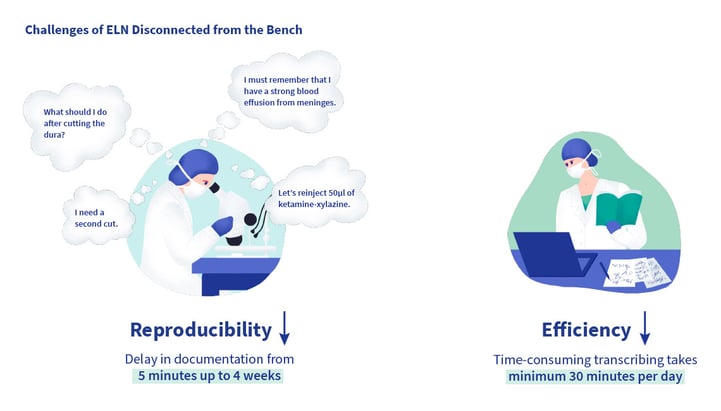
Left: An in vivo experiment during which it is impossible to take manual notes, requiring all information to be kept in memory throughout the surgery and written down later, impacting reproducibility. Right: Time spent transcribing paper notes into the computer, taking at least 30 minutes per day.
We understand the reluctance to abandon paper, especially in environments where computers are restricted from lab benches, as there was no appropriate solution until now.
Our innovative technology offers a mobile voice-powered user-friendly interface that seamlessly integrates with laboratory workflows, allowing scientists to capture data in real-time without the need for manual transcription. By bridging the gap between paper and digital formats, LabTwin facilitates the transition to ELNs, increasing adoption rates while minimizing disruptions to established laboratory practices.
Check our deeper analysis in the dedicated blog post - Challenge 1: Getting out of paper, increasing ELN adoption
With the ever-growing importance of data in scientific research, ensuring its quality and integrity remains a paramount challenge for laboratories. While the transition to digital documentation promises enhanced data management capabilities, the prevalence of errors or incomplete data threatens to undermine these efforts.
Traditional data capture methods, including manual transcription and recall, are prone to errors that can compromise the accuracy and reliability of data. From transcription mistakes to data entry errors, the risk of inaccuracies is large, casting doubt on the validity of research outcomes and jeopardizing regulatory compliance.
Furthermore, the delayed documentation inherent in manual processes exacerbates the risk of errors, as information may be misremembered or misrecorded over time. This not only undermines data integrity but also impedes scientific progress by hindering timely decision-making and analysis.
In the pursuit of higher data quality and integrity, laboratories must confront the challenge of reducing errors while enhancing data capture efficiency. While digital solutions offer promising avenues for mitigating errors, their effectiveness hinges on user acceptance and integration into existing workflows.
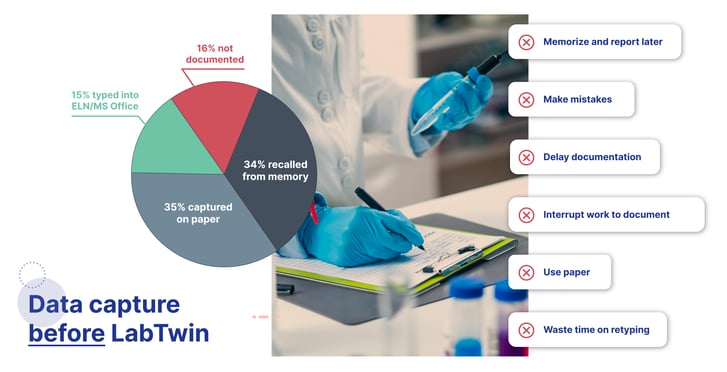
Analysis of the data capture methods at dsm-firmenich before the rolling out of LabTwin.
LabTwin recognizes the imperative of addressing these challenges, offering a solution designed to enrich data capture while minimizing errors. Through its convenient interface, real-time data capture capabilities and smart data processing, LabTwin streamlines the documentation process, reducing reliance on error-prone manual methods. By providing a platform for hands-free documentation with smart data validation checks and metadata enrichment, LabTwin empowers laboratories to enhance data quality and integrity while optimizing workflow efficiency. Have a look at the case study from dsm-firmenich and learn how they increase their data quality.
Check our deeper analysis in the dedicated blog post - Challenge 2: Enhancing data quality and integrity, richer data with less errors
A lot of time is lost with documenting and data not being FAIR slows down experiment turnaround and collaboration.
Not losing time by retyping things and having the data immediately accessible improves efficiency and accelerate experiment turnaround because the data to inform the next experiment is already available.
Efficiency and speed are essential in the fast-paced world of scientific research, where timely results can make all the difference. Yet, laboratories often find themselves grappling with inefficiencies that impede experiment turnaround and hinder scientific progress.
One of the primary challenges lies in the documentation process, where valuable time is lost to manual data entry and transcription tasks. The need to retype handwritten notes or manually input data into digital systems not only consumes precious time but also introduces the risk of errors and delays. Additionally, the fragmented nature of data storage and retrieval further exacerbates inefficiencies, as scientists struggle to access and analyze information in a timely manner.
Moreover, the lack of digitally available data within a short delay hampers collaboration and decision-making, as scientists are unable to access crucial information to inform their next experiment. This delay in data availability not only slows down experiment turnaround but also impedes the iterative nature of scientific inquiry, hindering the rapid iteration and refinement of experimental protocols.
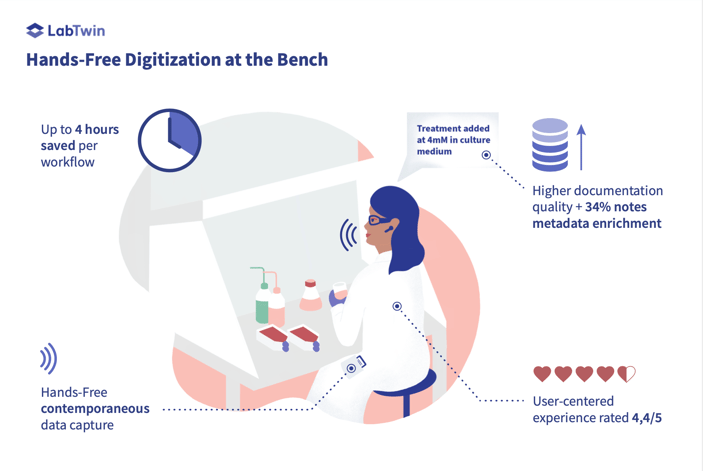
Quantitative and qualitative benefits of LabTwin voice-powered documentation
Through its hands-free mobile AI and voice-powered digital assistant, LabTwin enables real-time digital data capture and seamless integration with existing workflows. Then by automatically pushing this data to any lab informatics system (ELNs, LIMS), LabTwin instantaneously make this data available, empowering laboratories to improve efficiency and accelerate experiment turnaround.
Check our deeper analysis in the dedicated blog post - Challenge 3: Being more efficient and accelerating experiment turnaround
Standardization is the backbone of global scientific research, ensuring reproducibility and enabling AI/ML-powered cross-functional analysis. However, laboratories often struggle to enforce standardized procedures and data formats, leading to inefficiencies and challenges in data analysis and interpretation.
One of the primary hurdles lies in the diversity of protocols and data formats used across teams and sites. The lack of standardized procedures not only complicates data comparison and replication but also hinders collaboration and knowledge sharing. Moreover, the manual enforcement of standardized protocols poses logistical challenges, as laboratories struggle with the complexities of protocol dissemination, training, and adherence. Without effective mechanisms for standardization, laboratories risk compromising the integrity and reproducibility of their research, impeding scientific progress and innovation.
In their quest for standardization, laboratories must confront the challenge of implementing and enforcing standardized procedures and data formats across diverse research activities. Deploying ELNs and LIMS is the common solution for addressing these challenges, however their effectiveness relies on user engagement and accessibility at the point of experimentation.

At LabTwin, we recognize the imperative of addressing the challenge of standardization, offering a solution designed to facilitate standardization in procedures and data collection. Through its platform, LabTwin provides laboratories with a shared library of standardized protocols with versioning and data collection templates which can be called at the bench, promoting consistency and reproducibility in experimental workflows. LabTwin offers a solution to improving standardization at the very source of experimentation, enabling laboratories to uphold the highest standards of scientific integrity and reproducibility.
Check our deeper analysis in the dedicated blog post - Challenge 4: Improve standardization of procedures and data
Maintaining traceability is essential for ensuring compliance, quality control, and transparency in laboratory operations. However, many laboratories struggle to effectively track and document activities, leading to compliance risks and inefficiencies.
One of the primary obstacles is the manual nature of traceability processes, which rely on cumbersome paperwork and documentation. Without automated systems in place, laboratories face challenges in accurately recording and timestamping activities, increasing the likelihood of errors and discrepancies.
Moreover, the fragmented nature of data storage and retrieval further complicates traceability efforts, making it difficult to track the timing and sequence of laboratory activities. Without real-time visibility into actions and events, laboratories risk compromising compliance and regulatory adherence.
In their journey toward traceability, laboratories must endeavor to implement automated systems that streamline metadata capture and tracking processes.
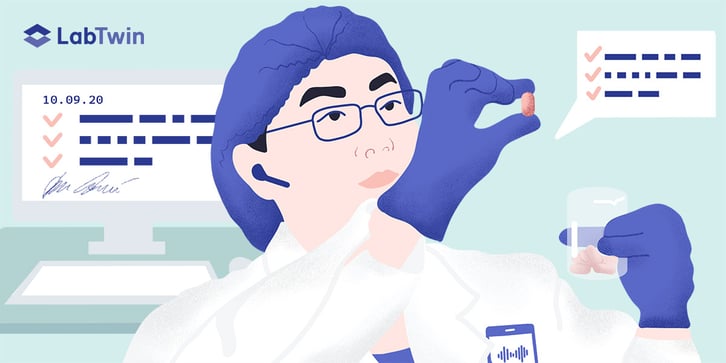 Streamlining traceability during lab work
Streamlining traceability during lab work
By being the scientist’s digital assistant, always carried around in the lab coat pocket, LabTwin is in the best position to provide real-time visibility into actions and events. With automatic timestamps, step validations and user identification, LabTwin streamline traceability and support laboratories in ensuring transparency and compliance.
Check our deeper analysis in the dedicated blog post - Challenge 5: Enhancing traceability in laboratory operations
Contamination poses a significant risk in laboratory settings, particularly during documentation processes that involve manual handling of paper or keyboards. The act of touching surfaces with contaminated gloves or hands can introduce pathogens or foreign substances, compromising the integrity of experiments and endangering the safety of laboratory personnel.
Traditional documentation methods, such as handwritten notes or keyboard data entry, increase the likelihood of contamination by requiring direct contact with surfaces. This risk is particularly concerning when working with sensitive biomaterials or hazardous chemicals, where even minor contamination can have serious consequences.
Moreover, the need to constantly sanitize surfaces and equipment adds an additional layer of complexity to laboratory operations, consuming valuable time and resources. Laboratories must strike a delicate balance between maintaining a clean and sterile environment while ensuring efficient documentation processes.
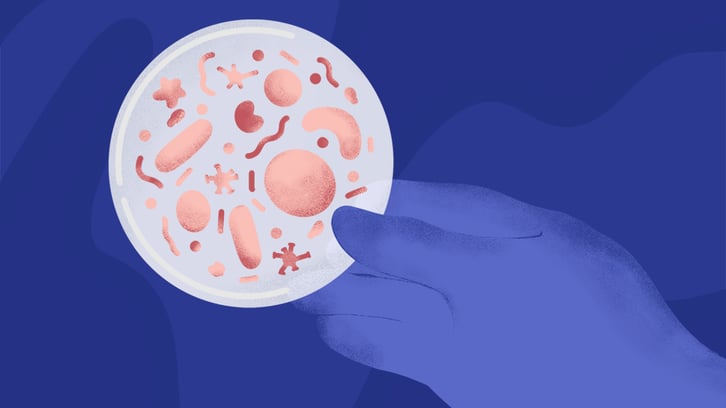
Microbiological culture in a Petri dish.
Through its hands-free mobile AI and voice-powered digital assistant, LabTwin enables scientists to capture data in real-time without making contact to keyboards or pens. By eliminating the need for direct contact with surfaces, LabTwin helps reduce the risk of contamination while streamlining documentation processes.
Check our deeper analysis in the dedicated blog post - Challenge 6: Minimizing contamination risks from documentation processes
Ensuring the safety of laboratory personnel is a top priority for research institutions and companies alike. However, maintaining a safe working environment in the laboratory presents a multitude of challenges, ranging from accessing safety protocols to adhering to best practices in real-time scenarios.
One of the primary obstacles is the accessibility of safety data and procedures at the moment of need. Laboratory personnel may encounter unforeseen hazards or emergencies during experiments, requiring immediate access to relevant safety information. Without real-time access to safety protocols, personnel may struggle to respond effectively to emergencies, increasing the risk of accidents or injuries.
Moreover, the traditional format of safety documentation, such as printed manuals or online databases, may be impractical or cumbersome to use in real-time scenarios. Laboratory personnel may be hesitant to disrupt experiments or workflow to retrieve safety information, leading to potential safety lapses or oversights.
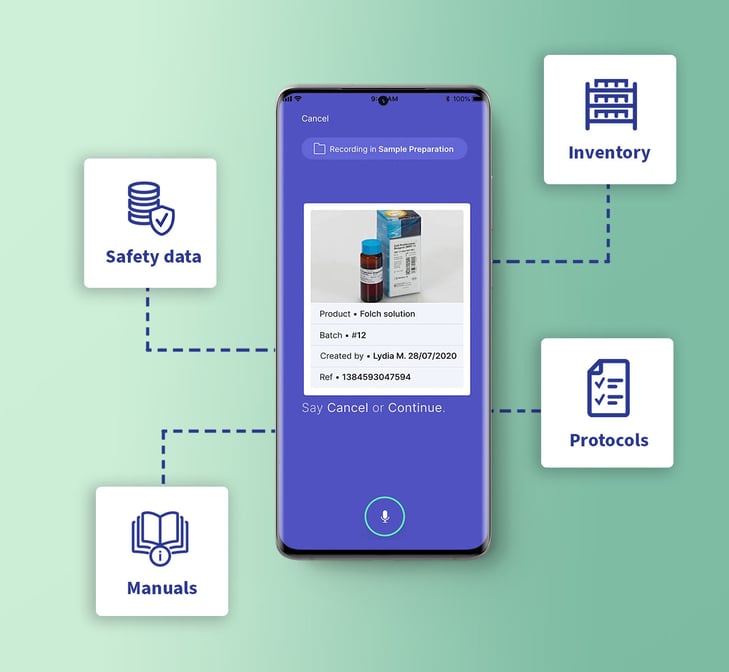
In order to enhance laboratory safety, laboratories must address the challenge of providing real-time access to safety data and procedures.
LabTwin enables laboratory personnel to access safety information and protocols in real-time, tailored to the specific needs of each situation. By providing instant access to safety data at the bench, LabTwin empowers laboratory personnel to make informed decisions and respond effectively to emergencies, thereby promoting a culture of safety in the laboratory.
Check our deeper analysis in the dedicated blog post - Challenge 7: Ensuring safety in laboratory environments
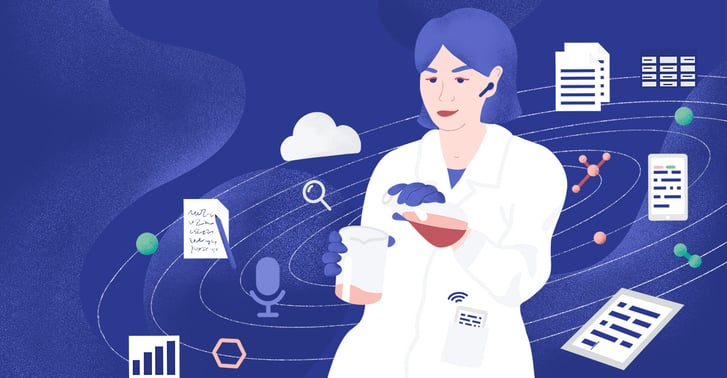
In navigating their digital transformation, laboratories must prioritize solutions that address practical challenges while promoting user acceptance and integration.
By equipping scientists with the right tools, laboratories can effectively alleviate a multitude of pain points simultaneously, enhancing efficiency, data integrity, collaboration, and safety.
Have you recognized your own laboratory's pain points in our discussion? We invite you to take the next step towards optimizing your laboratory workflows by requesting a demo of our solution with our team of scientists, experts in digitalization.

%20(1)-1.png?width=164&height=164&name=Ellipse%2052%20(Stroke)%20(1)-1.png)